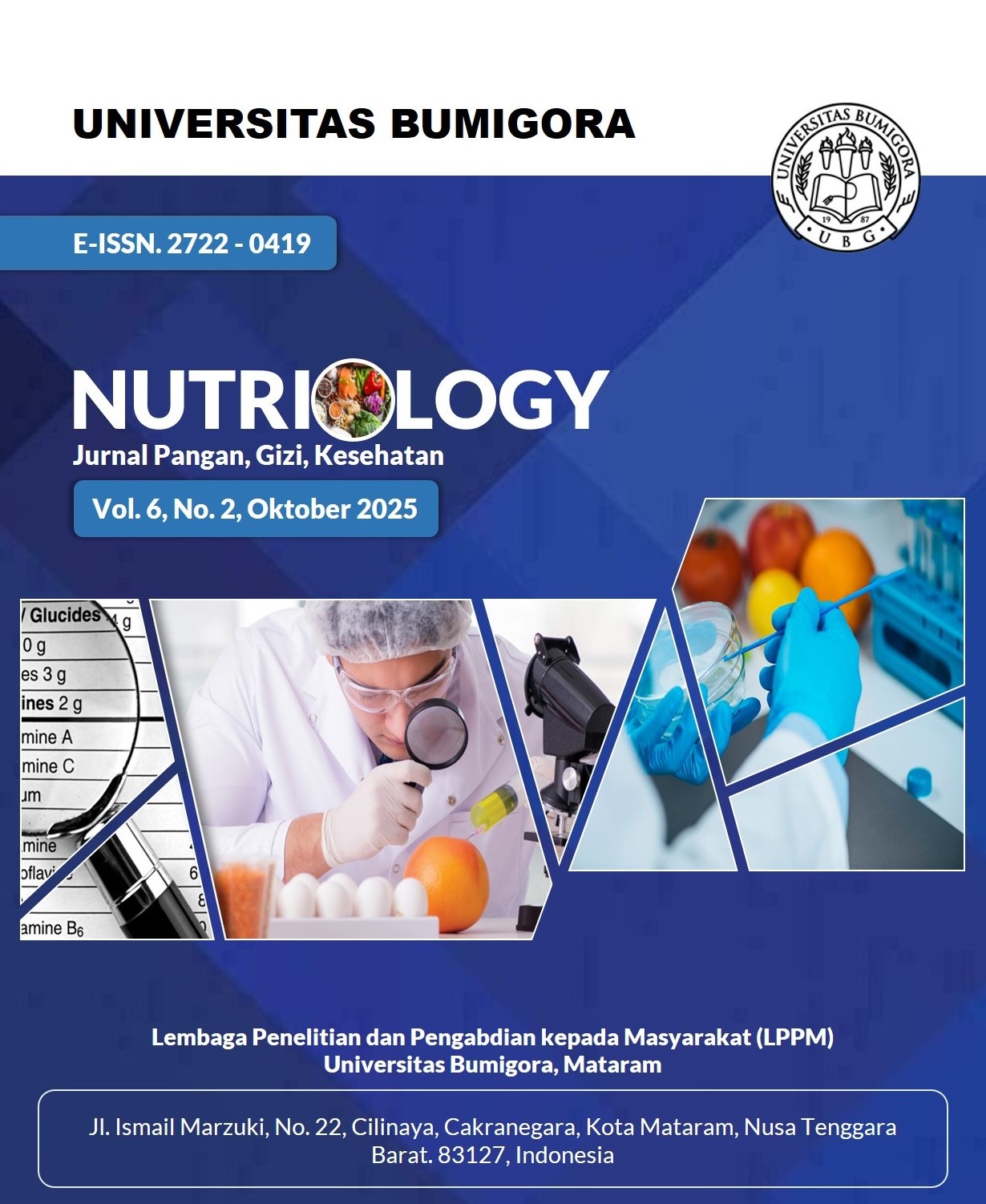Hygiene Ibu dan Sanitasi Dapur Rumah Tangga dengan Kejadian Stunting pada Balita: Pendekatan Cross-Sectional
DOI:
https://doi.org/10.30812/nutriology.v6i2.5503Kata Kunci:
hygiene ibu, sanitasi dapur, stunting, balitaAbstrak
Stunting is a condition of growth failure in children under 5 years of age caused by chronic malnutrition, repeated infections, and lack of adequate psychosocial stimulation. The prevalence of stunting in South Sulawesi in 2024 was still 23.4%. The purpose of this study was to analyze the relationship between maternal hygiene in food processing and household kitchen sanitation with the incidence of stunting in toddlers. The study design used was an analytical observational with a cross-sectional approach, involving 43 toddlers aged 6–59 months in the working area of the Sudiang Raya Community Health Center, Makassar City. Maternal hygiene data were obtained through the WHO Five Keys to Safer Food questionnaire, while kitchen sanitation data were based on the Regulation of the Minister of Health of the Republic of Indonesia Number 2 of 2023. The nutritional status of toddlers was measured through anthropometry and analyzed using the chi-square test. The results showed that 25 toddlers (58,1%) were stunted and 18 toddlers (41.9%) were normal. There was a significant relationship between maternal hygiene and the incidence of stunting (p = 0.018) and between household kitchen sanitation and the incidence of stunting (p = 0.004). Thus, it can be concluded that improving maternal hygiene behavior and kitchen sanitation can be an effective strategy for preventing stunting by reducing the risk of recurrent infections in toddlers.
Referensi
[1] S. J. W. Astuti, S. S. Dwiningwarni, and S. Atmojo, “Modeling environmental interactions and collaborative interventions for childhood stunting: A case from Indonesia,” Dialogues in Health, vol. 6, no. December 2024, p. 100206, 2025, doi: 10.1016/j.dialog.2025.100206.
[2] UNICEF, WHO, and W. B. Group, “Levels and trends in child malnutrition,” JME, vol. 24, no. 2, p. 32, 2023, [Online]. Available: https://www.who.int/publications/i/item/9789240073791
[3] Tim Percepatan Pencegahan Anak Kerdil (Stunting), Strategi Nasional Percepatan Pencegahan Anak Kerdil (Stunting). Jakarta, 2019.
[4] Kementerian Kesehatan RI, “Laporan Nasional Riskesdas,” Badan Penelitian dan Pengembangan Kesehatan, 2018.
[5] Kementerian Kesehatan RI, Hasil Studi Status Gizi Indonesia (SSGI), vol. 2, no. 1. 2021.
[6] Kementerian Kesehatan RI, “Survei Kesehatan Indonesia Dalam Angka,” Badan Kebijakan Pembangunan Kesehatan, 2023.
[7] Kementerian Kesehatan RI, Survei Status Gizi Indonesia. 2024.
[8] E. Sumartini, T. Danefi, F. Agustini, “Penyuluhan nutrisi tepat dan pencegahan penyakit infeksi sebagai upaya mencegah stunting,” Community Development Journal, vol. 5, no. 4, pp. 7945–7952, 2024, doi: https://doi.org/10.31004/cdj.v5i4.32814.
[9] E. Ogutu, A. Ellis, K. Rodriguez, “Determinants of food preparation and hygiene practices among caregivers of children under two in Western Kenya: a formative research study,” BMC Public Health, vol. 22, no. 1, pp. 1–18, 2022, doi: https://doi.org/10.1186/s12889-022-14259-6.
[10] Sutarto, R. Indriyani, R. D. P. Sari, “Hubungan kebersihan diri, sanitasi, dan riwayat penyakit infeksi enterik (diare) dengan kejadian stunting pada balita usia 24-60 bulan,” Jurnal Dunia Kesmas, vol. 10, no. 1, pp. 56–65, 2021, doi: https://doi.org/10.33024/jdk.v10i1.3415.
[11] S. Komala and R. Pangestika, “Hubungan Higiene Perorangan dan Sanitasi Lingkungan Dengan Kejadian Diare Pada Balita di Kelurahan Mekarjaya, Kota Depok,” Ruwa Jurai: Jurnal Kesehatan Lingkungan, vol. 18, no. 1, pp. 26–32, 2024, doi: https://doi.org/10.26630/rj.v18i1.4461.
[12] Y. W. Sari, B. Wirjatmadi, and S. W. Setyaningtyas, “The Relation Between Macronutrient Adequency Level Mother`s Personal Hygiene, Environmental Sanitation and Diarrhea with Stunting Incidences Among Childern Aged 24-59 Months,” Preventif : Jurnal Kesehatan Masyarakat, vol. 11, no. 2, pp. 94–104, 2020, doi: 10.22487/preventif.v11i2.114.
[13] Zahtamal, R. Restila, Sundari, “The influence of environmental sanitation on stunting,” Jurnal Kesehatan Lingkungan, vol. 16, no. 1, pp. 59–67, 2024, doi: 10.20473/jkl.v16i1.2024.59-67.
[14] J. Wolf, S. Hubbard, M. Brauer, “Effectiveness of interventions to improve drinking water, sanitation, and handwashing with soap on risk of diarrhoeal disease in children in low-income and middle-income settings: a systematic review and meta-analysis,” The Lancet, vol. 400, no. 10345, pp. 48–59, 2022, doi: 10.1016/S0140-6736(22)00937-0.
[15] H. Cerlyawati and E. Hartini, “Studi Analitik Observasional: Pengaruh Sanitasi Lingkungan terhadap Kejadian Diare pada Balita Stunting di Desa Kalongan, Ungaran Timur Kabupaten Semarang pada Tahun 2023,” Jurnal Kesehatan Lingkungan Indonesia, vol. 24, no. 1, pp. 68–74, 2025, doi: https://doi.org/10.14710/jkli.65166.
[16] E. Sugianti, B. D. Putri, and A. Buanasita, “The role of fathers in the incidence of stunting among toddlers in rural areas,” Amerta Nutrition, vol. 8, no. 2, pp. 214–221, 2024, doi: 10.20473/amnt.v8i2.2024.214-221.
[17] V. B. Lemaking, M. Manimalai, and H. M. A. Djogo, “Hubungan pekerjaan ayah, pendidikan ibu, pola asuh, dan jumlah anggota keluarga dengan kejadian stunting pada balita di Kecamatan Kupang Tengah, Kabupaten Kupang,” Ilmu Gizi Indonesia, vol. 5, no. 2, p. 123, 2022, doi: 10.35842/ilgi.v5i2.254.
[18] Kemenkes RI, Buku Saku Pemberian Makan Bayi dan Anak (PMBA) untuk Tenaga Kesehatan. Jakarta, 2021.
[19] Febriyanti, T. A. Endah, D. Purnamawati, “Akurasi presisi pengukuran antropometri balita oleh kader posyandu dalam mengidentifikasi kejadian stunting di Puskesmas Sadeng Pasar,” Jurnal Kesehatan Masyarakat, vol. 13, no. 1, pp. 27–42, 2025, doi: 10.14710/jkm.v13i1.46750.
[20] P. D. P. K. Dewi, K. A. P. Ningrum, P. S. Megaputri, “Peningkatan keterampilan kader posyandu dalam pengukuran antropometri untuk deteksi gizi bayi balita,” Jurnal Abdimas ITEKES Bali, vol. 4, no. 2, pp. 160–169, 2025, doi: https://doi.org/10.37294/jai.v4i2.689.
[21] R. R. T. Firmansyah, B. Murti, and H. Prasetya, “A meta-analisis of correlation between diarrhea and stunting in children under five,” Journal of Epidemiology and Public Health, vol. 8, no. 1, pp. 88–97, 2023, doi: 10.26911/jepublichealth.2023.08.01.08.
[22] A. Darmawan, N. R. Basry, and W. Wahyuddin, “Mother’s knowledge and hygiene sanitation against stunting in toddlers,” Jurnal Riset Kesehatan, vol. 11, no. 1, pp. 1–6, 2022, doi: 10.31983/jrk.v11i1.8060.
[23] S. Suparmi, M. F. Sasman, R. Ratnawati, “Hygiene and food safety practices among mothers as predictors of diarrhea risk in toddlers in Purwawinangun Village, West Java, Indonesia,” Frontiers in Public Health, vol. 13, no. March, pp. 1–6, 2025, doi: 10.3389/fpubh.2025.1530828.
[24] K. I. Sanin, A. Haque, B. Nahar, “Food safety practices and stunting among school-age children—an observational study finding from an urban slum of Bangladesh,” International Journal of Environmental Research and Public Health, vol. 19, no. 13, p. 8044, 2022, doi: 10.3390/ijerph19138044.
[25] J. Lin and X. L. Feng, “Exploring the impact of water, sanitation and hygiene (WASH), early adequate feeding and access to health care on urban–rural disparities of child malnutrition in China,” Maternal and Child Nutrition, vol. 19, no. 4, pp. 1–12, 2023, doi: 10.1111/mcn.13542.
[26] FAO, IFAD, UNICEF, et al., “The State of Food Security and Nutrition in the World,” The State Of The World, 2020, doi: 10.4060/ca9692en.
[27] S. Novianti, E. Huriyati, and R. S. Padmawati, “Safe drinking water, sanitation and mother’s hygiene practice as stunting risk factors: a case control study in a rural area of Ciawi Sub-district, Tasikmalaya District, West Java, Indonesia,” Ethiopian journal of health sciences, vol. 33, no. 6, pp. 935–944, 2023, doi: 10.4314/ejhs.v33i6.3.
[28] A. M. Zeleke, G. M. Bayeh, and Z. N. Azene, “Hygienic practice during complementary food preparation and associated factors among mothers of children aged 6–24 months in Debark Town, Northwest Ethiopia, 2021: An overlooked opportunity in the nutrition and health sectors,” Plos One, vol. 17, no. 12 December, pp. 1–17, 2022, doi: 10.1371/journal.pone.0275730.
[29] O. P. Gautam and V. Curtis, “Food hygiene practices of rural women and microbial risk for children: Formative research in Nepal,” American Journal of Tropical Medicine and Hygiene, vol. 105, no. 5, pp. 1383–1395, 2021, doi: 10.4269/ajtmh.20-0574.
[30] S. Bedada, T. Benti, and M. Tegegne, “Complementary food hygiene practice among mothers or caregivers in bale zone, Southeast Ethiopia: A community based cross-sectional study,” Journal of Food Science and Hygiene, vol. 1, no. 1, pp. 26–36, 2021, doi: 10.14302/issn.2835-2165.jfsh-20-3579.
[31] T. K. Soe, W. Laohasiriwong, K. Sornlorm, “Safely managed sanitation practice and childhood stunting among under five years old children in Myanmar,” PLoS ONE, vol. 18, no. 11 November, pp. 1–14, 2023, doi: 10.1371/journal.pone.0290600.
[32] A. Syukur, F. Fitriani, and Y. Yulia, “Hubungan metode pencucian dan penyimpanan dengan angka kuman peralatan makan pada warung ayam geprek di Pontianak Timur,” Media Kesehatan Politeknik Kesehatan Makassar, vol. 20, no. 1, pp. 63–71, 2025, doi: 10.32382/medkes.v20i1.1437.
[33] P. Dominguez-Salas, H. S. Waddington, D. Grace, “Understanding the role of household hygiene practices and foodborne disease risks in child stunting: A UKRI GCRF Action Against Stunting Hub protocol paper,” BMJ Paediatrics Open, vol. 8, no. Suppl 1, pp. 1–8, 2024, doi: 10.1136/bmjpo-2022-001695.
[34] S. M. H. Manalu, D. Syaputri, T. Bambang, “The effect of clean water facilities and household food sanitation hygiene on stunting in toddlers,” Contagion: Scientific Periodical Journal of Public Health and Coastal Health, vol. 5, no. 3, p. 969, 2023, doi: 10.30829/contagion.v5i3.17239.
[35] A. Adnani, R. Amelia, and S. V. Hutagalung, “Peran tikus liar sebagai pembawa parasit saluran cerna dan potensi risiko zoonosis: systematic literature review,” Syntax Literate ; Jurnal Ilmiah Indonesia, vol. 9, no. 1, pp. 312–322, 2024, doi: 10.36418/syntax-literate.v9i1.14851.
[36] M. N. N. Mbuya and J. H. Humphrey, “Preventing environmental enteric dysfunction through improved water, sanitation and hygiene: an opportunity for stunting reduction in developing countries,” Maternal and Child Nutrition, vol. 12, no. 1, pp. 106–120, 2016, doi: 10.1111/mcn.12220.
Unduhan
Diterbitkan
Terbitan
Bagian
Lisensi
Hak Cipta (c) 2025 Elfredo Josua Halawa, Fatmawaty Suaib, Lydia Fanny

Artikel ini berlisensi Creative Commons Attribution 4.0 International License.










